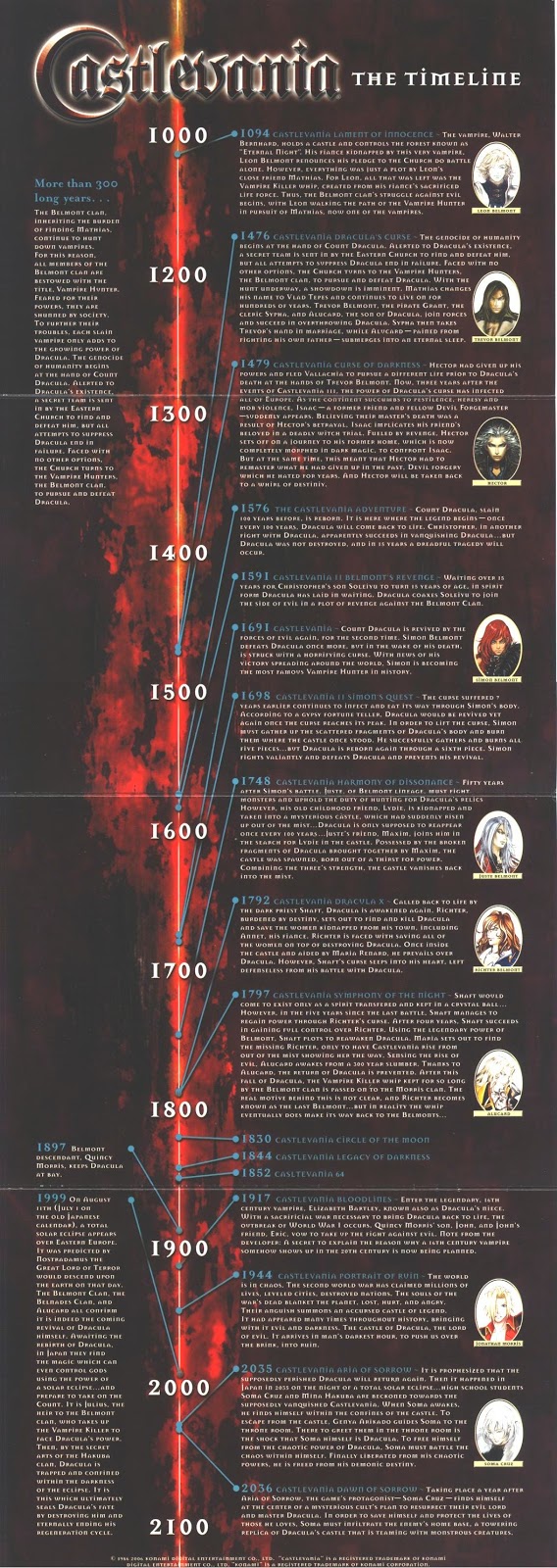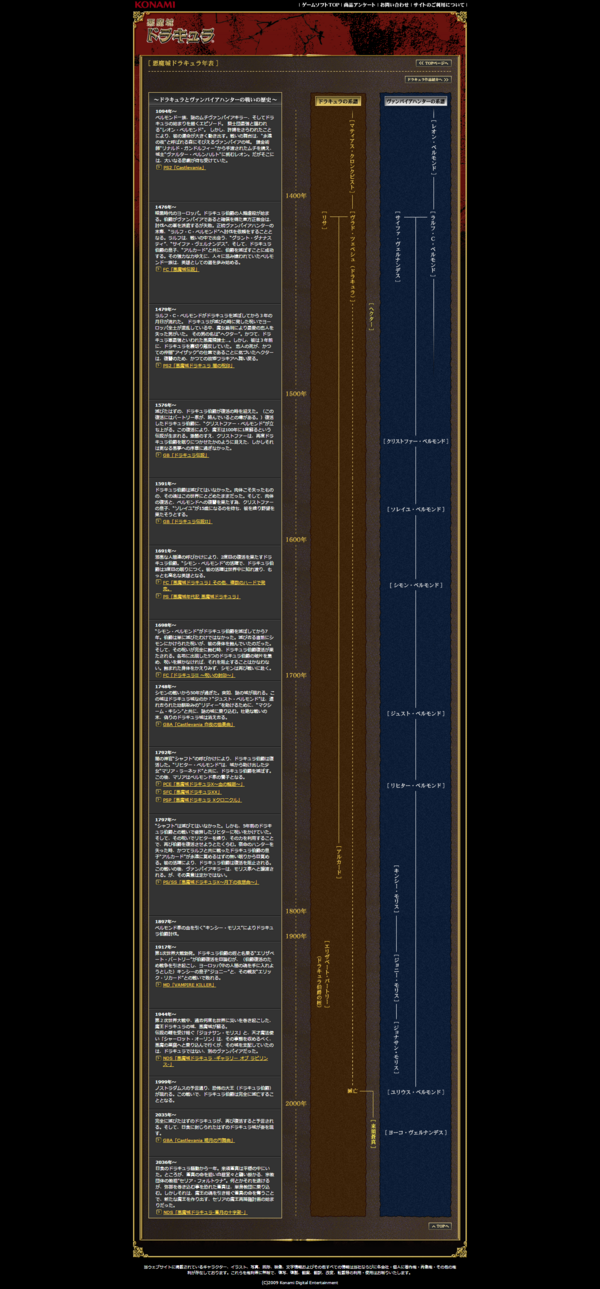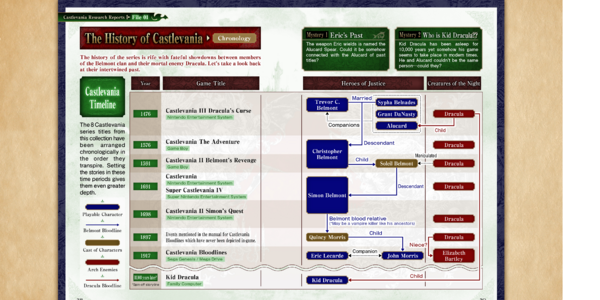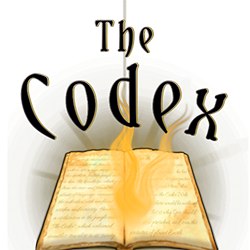
The official discord link if you wish to join the discord: https://discord.gg/j5RKwCvAFu
The background art comes from Cherylann1960.
Support the wiki on our official Ko-Fi page or Patreon page!
Castlevania Timeline
From The Codex
Introduction
The Castlevania timeline is a very popular talking point within the Castlevania fandom. However, over the years there seems to be a lot of non-sourced information, mistranslated uses, usage of the English localization solely, or purposeful misinformation spread causing much confusion. The sake of this page is to use only what's officially shown within the games and officially sourced interviews to create a coherent timeline.
Addressing Retcons
The Castlevana series is not at all new to retcons. A prevalent one is with the Vampire Killer itself, although the current lore is that the Vampire Killer was meant to be a whip the Belmonts used that Richter passed down to the Morris to uphold a prophecy, the original canon were that there were 3 magical whips, with the Vampire Killer being the Morris' originally and the Belmonts holding the "Excalibur".
It should also be noted that since retcons like these exist, contradictions will exist within the given games as the lore was changed at points within the franchise. Mainly the whip and the Belmonts being a strong point to it.
There have also been timeline-related retcons and several timeline renditions. For this article, the timelines will be looked at but will not be considered definitive as the latest timeline of all the games predates the release of Castlevania: Judgement, a game all about the timeline, and it is not one-to-one with it.
Addressing Misconceptions
The following will be going over some popular misconceptions within the Castlevania community.
"Gaiden" means "Non-Canon" or "Alternate Timeline"
This stems from the belief that when Iga or a producer calls a Castlevania game a "Gaiden" it is therefore non-canon or an alternate timeline and can be dismissed. This, however, is not the case.
The term "Gaiden" merely just means a side story, spin-off, or a separate tale. The term "Gaiden" does not determine the canonicity of a work, it just lets you know if the game is a spin-off/side-story or if it's a main story. Take, for instance, the Kingdom Hearts series. Kingdom Hearts: Chain of Memories would be considered a gaiden, as it's a side-story and spin-off title that isn't a mainline numbered title, however, it is in all manners canon and important to play to understand Kingdom Hearts II.
The same can be applied to Castlevania itself, Castlevania Symphony of the Night is a gaiden game. Yet it is very obviously canon and pretty important to play to understand more of Alucard's backstory. The idea of a Gaiden game for the Castlevania series itself would be any game not dealing with one of Dracula's main 100-year-resurrections, which in this case, even Castlevania 2: Simon's Quest is in a way a gaiden, despite being completely canon.
This is all to say that Gaiden does not at all mean "non-canon" or "alternate timeline" and should never be treated as such, the term itself has nothing to do with the canonicity of a product.
IGA Statements Quoted by a Fan
Any statements Iga has made about Judgement that don't come from this IGN interview or a sourced and reputable article are not usable. This is, of course, referring to the popular statements used when discussing Judgement's Canoncity about a fan asking IGA about the game's Canoncity on Facebook, here are some of them below:
- Fan: You mentioned Legend of Cornell was an alternate continuity. However, Cornell appears in Castlevania Judgment, which I believe is not an alternate continuity. How does that work? is he from a different universe than the other characters? It is not really explained in the game itself so I was hoping you could give some clarification on the issue.
- IGA: Judgment is a work that surpasses space and time and brings them together.
- Fan: I get it. So, is the explanation I suggested in the previous reply possibly correct?
- IGA: I don't think it's exactly correct. Judgment is a work born of thinking it would be fun to remove all the hedges and bring characters that appeared throughout the series together. I think that you need to view it as an event from another world which does not consider things like timelines or parallel dimensions at all.
Now these seem like pretty clear-cut statements until you start to try to find where these come from.
They come from both a timeline archive discussion on the Castlevania Wiki back on January 15th, 2012 and from a forum post from the same user as the wiki article.
There is no way to find anything sourced or verifiably proven that this person spoke to Iga. Trying to look up the person didn't get any real results either.
Some other issues fall under the inconsistencies within these Iga talks, the person claims that Iga confirmed that Order of Shadows and the Arcade are non-canon because they were intended from the very beginning to be such, however, an officially sourced interview has the lead game designer of Order of Shadows state that Iga was actively involved with ensuring the game was consistent with the current canon, this would be a weird thing to do if he intended it to be non-canon from the very beginning.
He also claims that Iga said Super Castlevania IV was an alternate continuity, when the wiki also notes Iga saying that the games are all legitimate and the same scenario of defeating Dracula, however this quote is also unsourced, they just claim Iga says this with no link or anything.
There is another one not related to the user who spoke to Iga, but a user on reddit who claimed that a magazine claimed that Castlevania: Circle of the Moon was stated to be in a "different time axis". Attempting to get it translated got no wording that said anything like that, with it not even mentioning anything about canon, timeline, time axis, or any other wording of the sort in a machine-translated attempt. Do note however that this is a machine translation so it could potentially be that it is there, but until a reputable and verifiable translator can confirm or deny this translation, the jury is out with it and it will not be used for the canoncity of Circle of the Moon.
Thus all of these quotes are merely hearsay until shown or proven otherwise.
Iga Only Allows Stuff He Works on To Be Canon
There is a weirdly believed idea in the fandom that Iga only considers works he worked on canon, however, an officially sourced interview has the lead game designer of Order of Shadows state that Iga was actively involved with ensuring the game was consistent with the current canon, along with this Iga did not work on a lot of Castlevania games considered canon, such as the NES trilogy and the Gameboy games. In fact, he has only made 12 Castlevania games, out of the 30 Castlevania games in total, and most of them from the older console eras are still a part of the canon. Thus Iga does not only allow stuff he works on to be canon.
The Timeline
1094 A.D. Castlevania Lament of Innocence
Dracula is not even Dracula yet within this game, he is Mathias and steals Walter's soul in order to gain his dark lord powers. Leon Belmont starts the legend of the Belmont Hunters being the ones to fight against the night. With the ending noting this the beginning of the Belmont clans struggle against evil. WitH Mathias and the Belmonts not meeting again for hundreds of years.
1470s A.D. Castlevania: Judgement Sypha
Sypha's story takes place years before the events of Castlevania III. It's even shown in Trevor's story she has no idea who Trevor is and Trevor notes she looks so young.
1476 A.D.[1] Castlevania III: Dracula's Curse
1476 A. D. Castlevania Curse of Darkness Manga
The events of the manga takes place during Dracula's war on humanity, which are the events of Castlevania III: Dracula's Curse.
1479 A. D. Castlevania: Judgement Trevor
This takes place several years after Trevor defeated Dracula. Trevor even notes to Grant it's been "many moons" since their last match. The same to Alucard. His ending shows this version is leading directly into the events of Curse of Darkness.
1479 A. D. Castlevania Curse of Darkness
Noted by Iga to take place three years after the events of Castlevania III.
1576 A. D.[2] Castlevania: The Adventure/Castlevania: The Belmont Legacy/Castlevania: The Adventure ReBirth
1591 A. D.[3] Castlevania II: Belmont's Revenge
Late 1600s Castlevania: Order of Shadows
1691 A. D.[4] Castlevania/Haunted Castle/Super Castlevania IV/Castlevania Chronicles/Haunted Castle Revisited
1692 A. D. Castlevania: Judgement Simon
The Simon from Judgement is after his fighting Dracula for the first time, along with taking six years before Simon learns of the curse placed on him.
1698 A. D.[5] Castlevania II: Simon's Quest
1748 A. D. Castlevania: Harmony of Dissonance
1792 A. D. Castlevania: Rondo of Blood/Castlevania: Dracula X/Castlevania: The Dracula X Chronicles
1795 A. D. Castlevania: Judgement Maria
This takes place several years after Maria aided Richter Belmont in defeating Dracula, with the story ending with next year Maria setting out in search of Richter and a year into her quest Castlevania suddenly reappearing, making this 2 years before Symphony of the Night.
1797 A. D. Castlevania Symphony of the Night
1798 A. D. Castlevania: Nocturne of Recollection (Radio Drama)
A year has passed since the events of Symphony of the Night[6].
1844 A. D. Castlevania: Judgement Cornell
Cornell's story takes place right before the events of Castlevania Legacy of Darkness.
1844 A. D. Castlevania: Legacy of Darkness
Initially the Nintendo 64 Castlevania games were removed by Iga, however Cornell and his story showed up in Castlevania: Judgement, with Iga stating in an interview for Judgement that all of the heroes are pulled from different periods of the Castlevania timeline, showing it's officially considered apart of the timeline as this goes past the 2007 Konami Japanese timeline, as Castlevania Judgement was released in 2008.
1852 A. D. Castlevania 64
Late 1800s A. D. Castlevania: Judgement Shanoa
Shanoa's story takes place during the events of Order of Ecclesia.
Late 1800s A. D. Castlevania: Order of Ecclesia
1897 A. D.[7] Castlevania Bloodlines: Game Manual
Events mentioned within the game manual of Bloodlines, are noted to take place here[8].
1907 A. D. Castlevania: Judgement Eric Lecarde
1917 A. D.[9] Castlevania: Bloodlines
1944 A. D. Castlevania: Portrait of Ruin
1999 A. D. The Big War
In the year 1999, Julius Belmont along with others seized Dracula's castle within a Solar Eclipse and killed him for good.
2035 A. D. Castlevania: Aria of Sorrow
2036 A. D. Castlevania: Dawn of Sorrow
2037 A. D. Castlevania: Requiem of the Divine Abyss
10,000 Years Later[10] Kid Dracula
Events that Can't Be Given a Direct Year
Castlevania: Grimoire of Souls
The intro of the game shows that it takes place past all of the prior Castlevania games, even Dawn of Sorrow, where someone sent Genya Arikado a letter requesting his aid.
Castlevania: Harmony of Despair
Harmony of Despair is a game about all of the history recorded within the grimoire, this has no real timeline placement as it's all periods in the timeline.
Castlevania Series that are not Canon
1830 A. D. Castlevania: Circle of the Moon
Although it was in the original 2006 timeline, it was removed by Iga from the timeline, along with Castlevania 64, Legacy of Darkness, and Legends.
Castlevania Lords of Shadows
They're directly noted in an interview with the lead developer, that the game has nothing to do with the canon, sharing none of the lore or original stuff for the characters.
Castlevania Legends
The game was originally meant to be a prequel to all the other games in the Castlevania series, this can be seen with Sonia's boss fight against Dracula serving as the first time Dracula ever encountered a Belmont along with the ending of the game saying "this story marks the beginning of the Belmont family legend that has been passed on through many ages". Along with this, Sonia shared a relationship with Alucard, heavily implying that her child is between her and Alucard. The existence of Lament of Innocence already greatly messes with this. The game manual even mentions that Sonia was the first of the Belmont family to leave her name to posterity as a vampire hunter[11]. Despite Leon Belmont being the one to start the legend of the Belmont Hunters being vampire hunters. Along with this, Trevor is canonically the first Belmont to defeat Dracula. Iga has gone out of his way to note too that Castlevania Legends was intentionally redacted from the timeline so that it doesn't conflict with the timing used in other titles.
Castlevania Netflix (Both The original Netflix series and Castlevania: Nocturne)
This series is an adaptation of both Castlevania III: Dracula's Curse and Castlevania: Rondo of Blood, greatly differing from both of them with characters, events, and lore.
Conclusion
This page will sometimes receive updates or try to explain more in depth the events, though this is a page that goes over the full timeline using official sources and verifiable proof.
References
- ↑ Castlevania Anniversary Collection Bonus Book Pages 29-30
- ↑ Castlevania Anniversary Collection Bonus Book Pages 29-30
- ↑ Castlevania Anniversary Collection Bonus Book Pages 29-30
- ↑ Castlevania Anniversary Collection Bonus Book Pages 29-30
- ↑ Castlevania Anniversary Collection Bonus Book Pages 29-30
- ↑ Castlevania Nocturne of Recollection
- ↑ Castlevania Anniversary Collection Bonus Book Pages 29-30
- ↑ Castlevania Anniversary Collection Bonus Book Pages 29-30
- ↑ Castlevania Anniversary Collection Bonus Book Pages 29-30
- ↑ Castlevania Anniversary Collection Bonus Book Pages 29-30
- ↑ Castlevania Legends Game Manual Pages 2 & 12


